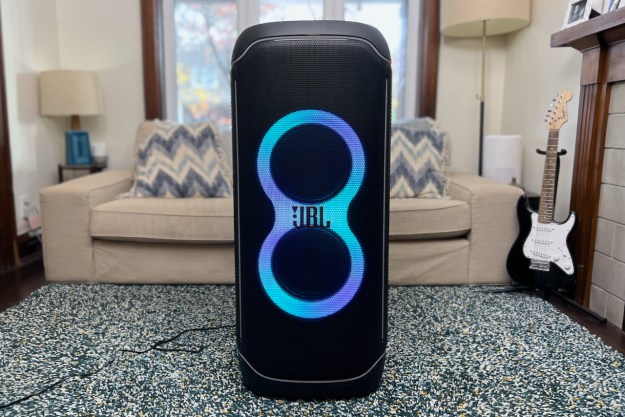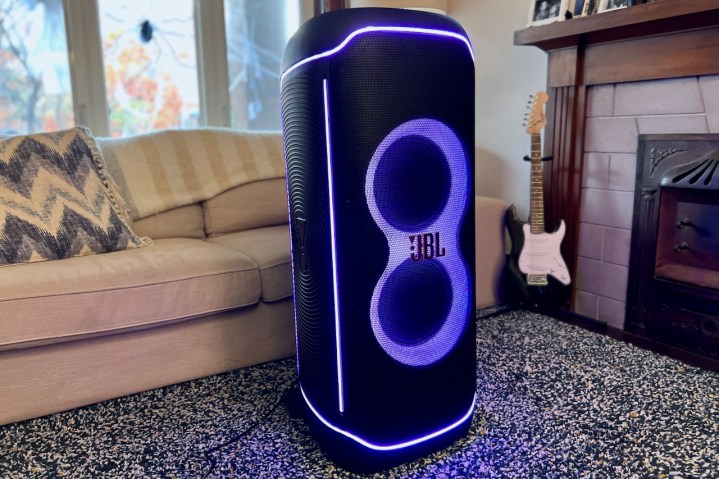
- It's loud. Really loud.
- It's also crystal clear and defined
- Wi-Fi connectivity means hi-res audio
- The app is excellent
- Mic and guitar inputs
- Well-designed control panel
- It's big and heavy
- Karaoke features could be better
- Pricey
I had completely forgotten that JBL was sending me its latest party speaker to review. There were some delays in shipping it to my home in Canada, and it just slipped my mind. Then one day, as if to ask, “remember me?” the 87-pound JBL PartyBox Ultimate landed on my porch in a box the size of a small refrigerator. Standing nearly 4 feet tall, the thing is a beast. And I mean that in the best possible way.
The newest and biggest of JBL’s party speaker lineup, the flagship “Ultimate” couldn’t live up to its name any more than it does. It’s a bona fide party in a box that you can wheel into any room, dance hall, or backyard to turn the place upside down with sound and light. At 1,100 watts RMS, it’s one of (if not the most) powerful party speakers on the market, and it’s the loudest and clearest-sounding I’ve ever heard, without breaking a sweat.
For just $1,700, a casual working DJ would be good to go, out of the box, with this speaker. The Ultimate has built-in lights, mic inputs, sound effects, wheels, and a sturdy handle for lugging it from gig to gig. However, that price isn’t even unreasonable for those just looking to party — it does karaoke, has an excellent companion app, you can plug a guitar into it, and with Wi-Fi connectivity, it can stream hi-res audio and connect to your TV for movie night, too (it even supports Dolby Atmos). It may be huge, and preposterously loud, but after a couple of weeks with the JBL PartyBox Ultimate, I was surprised by its sound quality and its versatility. Let’s dig deeper.
JBL PartyBox Ultimate: design
Did I mention how big the PartyBox Ultimate is? It’s worth repeating. I live in a modest-sized suburban Toronto house, and I had to clear the furniture out of my living room to make space for the unboxing. It comes well-packed in Styrofoam, though, and was relatively easy to get out of the box. If you’re doing it alone, however, follow the instructions printed on the box’s flap (always read the instructions, boys and girls), as it makes it manageable for one person.
The speaker stands at 41.3 inches by 18.9-inches deep and 17.3-inches wide. And, as mentioned, it weighs a hefty 87.1 pounds, roughly 10 pounds heavier than JBL’s outgoing champion, the JBL PartyBox 1000, and more than any other party speaker I’ve ever come across. One public service announcement I can make about the PartyBox Ultimate is to not lift it by yourself. Sure, it has a sturdy plastic handle, the wheels are big and smooth, and it rolls around with ease. But don’t even try to get this thing up or down a set of stairs on your own. Your back will thank you.
The outer shell is a hard, rugged plastic, except for the metal speaker grille emblazoned with the JBL logo. The Ultimate is built like a missile and carries an IPX4 splashproof rating, so pool parties or a little rain (or a spilled cocktail) won’t be a problem. Behind the grille sits an array of six JBL drivers: two honkin’ 9-inch subwoofers, bordered with LEDs that make up the main look of the speaker, two 4.5-inch midrange speakers, and two 2.75-inch tweeters. On the back bottom of the speaker is also a bass port for additional low end. What didn’t carry over from the PartyBox 1000 is the bottom-facing subwoofer, but the Ultimate doesn’t need it. JBL says that the Ultimate has the power to “rock [a space] the size of two basketball courts,” which, from my experience, is 100% true.
Consistent with a lot of party speakers, all the controls are well-situated on the top panel of the device and are easy to access. Two large dials control volume and lights, and you’ll also find a Bluetooth pairing button, bass boost, and the multi-speaker connect button. Above that is the programmable party pad (more on this later), and above that are volume, EQ, and echo knobs for the main microphone. There’s even a slot where you can mount your smartphone or tablet. Unlike some party speakers, you can control most of the Ultimate’s features from this top panel without the need of the companion app, which is great because you don’t need to rely on having your phone with you all the time.
The PartyBox Ultimate is balanced, articulate, and one of the clearest-sounding speakers I’ve ever heard.
On the back of the Ultimate, behind a rugged protective flap, you’ll find a panel of inputs, including two quarter-inch jacks, one for the main mic and another for mic 2/guitar, as well as a USB-A port for USB sticks and charging devices, a 3.5mm AUX in, and in/out ports for daisy-chaining to other PartyBox Ultimate speakers. There’s also a compartment for storing the power cable, which makes this the perfect time to mention that the Ultimate does not have a battery, so it must be plugged in. But with this kind of juice, that makes sense.
JBL PartyBox Ultimate: connectivity
Getting connected to the PartyBox Ultimate is easy and there are many options. It can connect via Wi-Fi (which is new for JBL party speakers, and rare for party speakers in general) and Bluetooth 5.3, as well as throughline input, AirPlay, Alexa Cast, and Chromecast. The JBL One app is well-designed and is the usual hub for all this connectivity, but Spotify Connect and Tidal Connect support means you can control those streaming services with their apps instead, if you prefer those interfaces. AirPlay also allowed me to connect the Ultimate to my Apple TV 4K for some serious movie sound, as well as access to my music streaming apps installed on it. This is also fun at gatherings because the song details and album art displays on your TV.
I was most interested in checking out the PartyBox Ultimate’s Wi-Fi abilities, though, which not only allowed me to put it to the test with hi-res, lossless quality music thanks to native Tidal, Qobuz, and Amazon Music integration in the JBL One app, but it also let me listen to Dolby Atmos-encoded music tracks (it’s worth noting, though, that if there’s no Wi-Fi access, you won’t be able to play hi-res music at all, as the Ultimate’s Bluetooth does not support it).
The dedicated Wi-Fi connection also meant that phone notifications that would have normally rumbled out of the speaker over Bluetooth stayed confined to my phone — 100-plus decibels of tri-tone text message notifications will not sound pleasing at your party.
JBL PartyBox Ultimate: sound and performance

If you’re familiar at all with JBL’s pleasant little chime tone when you turn on one of its Bluetooth speakers, the PartyBox Ultimate has this, too — except that it shook my house. And things just got crazier from there. As advertised, the Ultimate’s power is authoritative, with the ability to effortlessly push out the kind of volume you’d find in a nightclub or a really good wedding. At less than 40% volume, it rattled my walls and made the floors vibrate. And that’s without the bass boost.
But it’s actually ham-fisted to just call it loud. The PartyBox Ultimate is balanced, articulate, and one of the clearest-sounding speakers I’ve ever heard, even at unreasonable volumes. I managed to lug the speaker to my family’s cabin for a weekend so I could let it fly in a bigger room and with no one around for miles. And if you would have walked by while we were just punishing the cabin walls with everything from Dua Lipa, Daft Punk, and Wu Tang to My Bloody Valentine, New Order, and Soundgarden, all synced up with the Ultimate’s light show, you might have stood in line to get in. (And my cabin has a two-drink minimum.)

I tested the Ultimate at a variety of volumes, ranging from around the 10% level to 30% and as loud as around 60%, where I only left it for a few seconds because it was just too loud. I’m sure in a much larger space, like a banquet hall, you could push it, but that’s about as far as I was willing to go. What’s impressive is how it performed throughout the range — clean and bright highs without fatiguing the ears, detailed and uniform mids, and punchy, tight bass that just saturates and fills your chest with tracks like Billie Eilish’s Xanny (my go-to bass track).
There’s also a two-level Bass Boost button that either adds more round and fat saturation (“Deep”) or tightens things up with more of a mid-chest punch (“Punchy”). And for further fine-tuning, the JBL One app has a decent five-band EQ with savable presets. It performs well no matter which streaming service you use.
I was also curious to check out the Ultimate’s Dolby Atmos compatibility. While most people won’t use this, it’s new for JBL party speakers and touted in their marketing materials. The short version is that it’s just OK, but it depends on a few things. You need to be connected to Wi-Fi (it doesn’t work over Bluetooth, AirPlay, or Chromecast) and the streaming service needs to have Dolby Atmos music tracks available, so we’re talking Tidal, Amazon Music, or Apple Music. However, the latter has no native connection in the JBL One app (the others do). And since AirPlay doesn’t support Dolby Atmos or hi-res audio, you won’t be able to listen to those through the Ultimate.
That said, it’s not a deal breaker. Some Atmos tracks sound better than others, and while some do it well, throwing nuances like drums, vocals, and cool melody lines to other parts of the room, the 3D effect is slight. Plus, it lowers the volume of the Atmos tracks substantially, so you have to goose it up, which means that you have to be sure to drop the volume when a non-Atmos track comes on or else … boom.
The Ultimate also boasts an automatic room-tuning feature that some people might know from their Sonos speakers, but you can’t really test it because it happens automatically. But the speaker sounds great no matter where it’s placed — corners, against the wall, out in the open, outside — so I assume it works as advertised. The other features I couldn’t test were the stereo pairing and daisy-chaining capabilities (I only had the one speaker, thank goodness), which allow you to connect multiple Ultimates together either wirelessly or with 3.5mm cables for either stereo sound or just an all-out sound assault that I could see coming in handy for larger parties.
JBL PartyBox Ultimate: light show and party features

They’re called “party speakers” for a reason, and that, of course, goes beyond just being loud. And while professional party DJ and lighting outfits might sniff at the Ultimate and others of its ilk, there are enough fun features baked in here for most people to throw a decent barn burner.
All those features are controlled by the feature-rich JBL One app, but let’s start with the lights. In short, the PartyBox Ultimate lights up like a Christmas tree, with LEDS circling the twin nine-inch woofers, strobes dotted around the face, and several lines of LEDS accentuating the top, sides, and bottom of the speaker. With more colors and presets than you’ll ever need, you can tweak away to create a custom light sequence or just let it pulse along to whatever music you’re playing. You also can control which lighting effects are mapped to the physical light show dial on top of the speaker.
Are the Ultimate’s lights bright enough for a big ballroom? No, not on its own. But it’s still fun and bright enough for a small-to-medium-sized venue. A couple more of these set up around a room, however, would be impressive, if you happen to have an extra $3,400 lying around.
For the DJs, the Ultimate’s sound effect capabilities are just as diverse. The five-slider Effect Lab section of the app is a ton of fun, and me and my 12-year-old daughter had a field day remixing Billy Eilish’s Bad Guy into a club track. “Filter” adds an envelope filter (it’s that sound that makes it feel as though everyone has been pulled under water and back), and “Echo” adds an escalating and de-escalating amount of echo. There are three other trippy effects that are controlled with sliders in the app so you can add/remove intensity. It’s a ton of fun.
Another swipe to the right opens up a range of sound effect buttons, including the ever-popular horn, vinyl scratching sounds, and hand claps, as well as vocal shouts like “Hey,” “Party,” and “Jump!” All of these sounds can be customized and mapped to the party pad on top of the speaker for easy access, and you can create an endless number of presets for them. Click the images below for more detail.
Lastly, what would a DJ or emcee be without a mic? The PartyBox Ultimate’s main mic sounds clear and loud and can be controlled with physical knobs on top of the speaker, which is great because you don’t have to crawl around to the back panel like on other speakers. You can also use the app to control these settings, too.
For the other input, you just have to flip a switch to select whether you’re using a mic or a guitar. Both sound great, with excellent amplification that does have to be controlled with a tiny volume dial on the back, which is its only drawback.
As for the Ultimate’s karaoke features … meh. If this is an important feature for you, there are speakers that do this much better. The Ultimate’s marketing materials say that it has “karaoke EQ tuning,” which, as I’ve seen in other party speakers like the LG XBoom XL7, had me expecting its nifty feature that can strip the vocals out of nearly any track from any source, including streaming services.
To my disappointment, this is not the case with the Ultimate. While you can adjust the bass, tone, volume, and echo of the mic, that’s it. However, that doesn’t mean it’s not an excellent karaoke speaker if you have karaoke-ready tracks to play, or if you use a feature like Apple Music’s Sing. The power of the speaker and mic (and guitar) inputs should make for a fun jam session, either way.
JBL PartyBox Ultimate: bottom line
The JBL PartyBox Ultimate is just that — the ultimate party speaker that JBL has ever made, and quite possibly that anyone has ever made. Its 1,100-watt output is, to use the technical term, bananas, and will be most appealing to people like casual working DJs (pros could make it work, too) and those who throw a lot of big parties or public gatherings (schools would love it) in medium-to-large spaces. There is also the question of the $1,700 price, which I think is a good value for its capabilities. It is hefty to move around as well, but the payoff is equally so.

Not to belabor the point, but the Ultimate is very, very loud, but also crystal clear and refined whether you’re playing grunge tracks, club bangers, or rallying partygoers to the dance floor on the mic for the Macarena (Google it). Its Wi-Fi connectivity is mainly what sets it apart from its predecessor, the JBL PartyBox 1000, which is also 1,100 watts, has many of the same lighting and DJ features, and is $400 cheaper (or even more so if you can find it on sale). But it’s the Wi-Fi connectivity that, in my opinion, makes the Ultimate the better choice, as it gives you access to higher-quality audio from hi-res streaming sources, more connectivity options, and Dolby Atmos. However, if it’s just volume you’re after, then the PartyBox 1000 would be an excellent choice, too.
Are there other options? Of course. The Soundboks 4 ($999), the LG XBoom lineup ($300 to $600), and Sony’s SRS-XV range of party speakers ($650 to $900), for example, are certainly loud enough for most people, will save you some money, are battery-powered and lighter for better portability, and have many of the same DJ and lighting features (with the exception of the Soundboks). By all means, if one of these fits your budget and your uses, get one. Or three. But if you find yourself regularly needing to rattle all four walls of a banquet hall-sized room (and everyone in it), then you might want to go Ultimate.
Editors' Recommendations
- Best wireless speakers for 2024: Sonos, JBL, KEF, and more
- KEF LS60 bring wireless hi-res audio to floor-standing speakers
- Denon unveils Denon Home: Three new wireless multiroom speakers
- JBL’s colorful new wireless speakers brighten up any party or situation



























